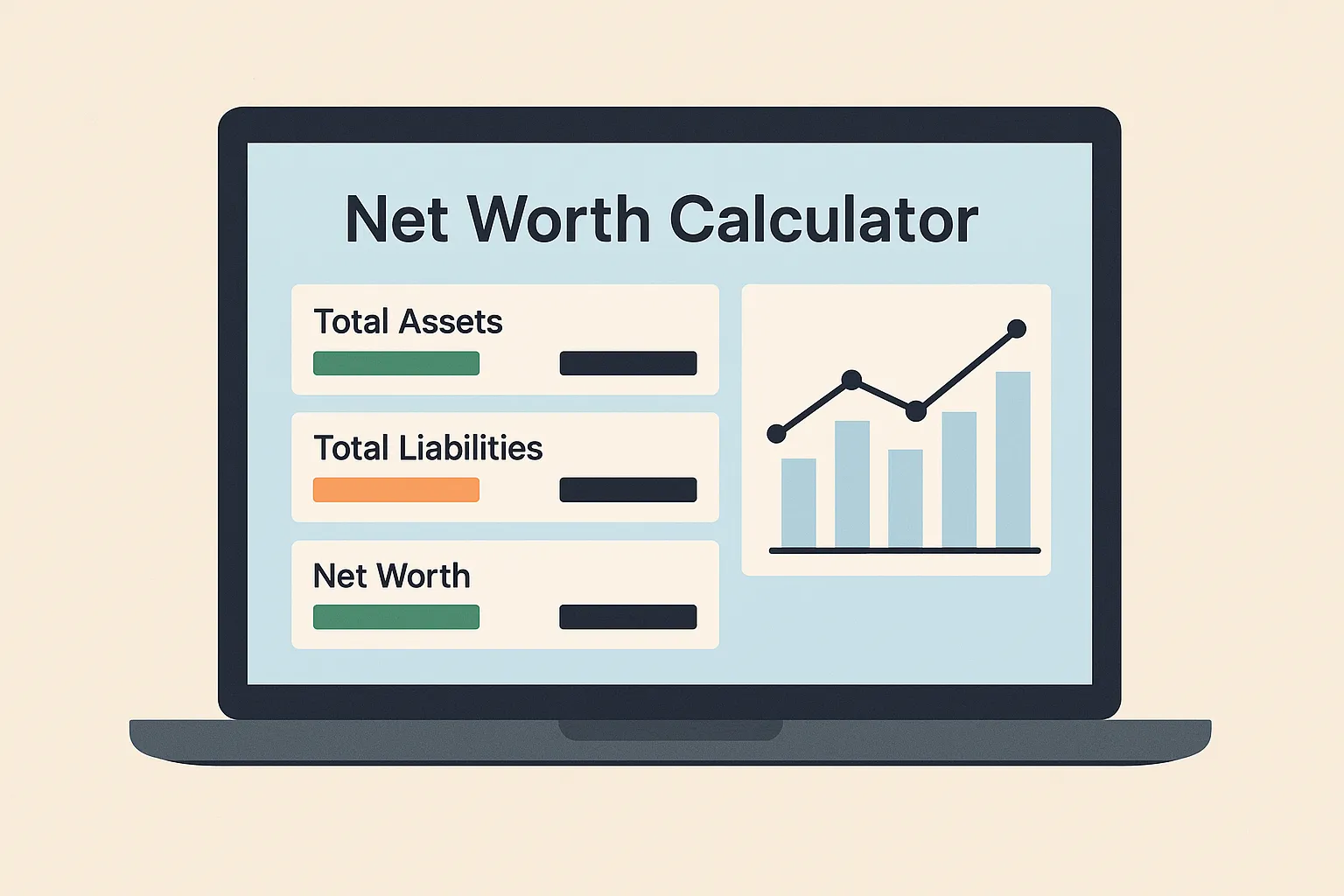Net Worth Calculator - Tool

What the Net Worth Calculator Is For
A Net Worth Calculator totals assets (things with monetary value) and liabilities (debts and obligations) and outputs three core numbers: Total Assets, Total Liabilities, and Net Worth. The calculator helps investors organize scattered accounts into a single picture - useful for goal-setting, debt strategy, and discussing big moves like buying a home or rebalancing investments. Investor.gov calls this a “net worth statement”: a straightforward ledger of what’s owned and owed.
Key Takeaways
- Net worth = assets – liabilities. A calculator just standardizes the list and the math.
- Consistency beats precision. Using the same categories and update cadence (monthly or quarterly) makes trends meaningful - useful for planning and risk checks.
How to Use the Calculator (Field-by-Field)
1) Assets: “What you own”
Each line asks for a current, good-faith estimate. If unsure, be conservative.
- Cash & Checking/Savings. Bank balances - easy to verify.
- Taxable Investments. Brokerage accounts holding stocks, ETFs, bonds, or money market funds. Use current account value.
- Retirement Accounts. 401(k), 403(b), IRA, Roth IRA. The calculator typically takes full market value; taxes are separate considerations.
- Real Estate (Primary & Other). Estimated fair market value. Consider using recent comps or appraisal ranges - overstating here can distort the result.
- Business/Private Equity. If applicable, use a conservative estimate or last financing valuation haircut.
- Vehicles & Personal Property. Cars (use a pricing guide), higher-value items (art, jewelry) if they would reasonably be sold for cash.
- Other Assets. HSAs, 529s, vested RSUs, CDs, Treasury bills.
Why it matters: Assets show savings power and liquidity options. The mix (cash vs. investments vs. real estate) can hint at risk concentration and future cash-flow needs.
2) Liabilities: “What you owe”
Enter remaining balances - not monthly payments.
- Mortgage(s). Outstanding principal.
- Home Equity Line / Personal Loans. Current drawn balance.
- Student Loans. Total remaining across servicers.
- Auto Loans. Remaining principal.
- Credit Cards. Statement balance if carried; if paid in full monthly, many users enter $0.
- Other Debts. Margin loans, buy-now-pay-later, tax liabilities due.
Why it matters: Liabilities show fixed obligations that reduce flexibility. Large short-term debt balances can overwhelm cash cushions even if headline net worth looks healthy.
3) The Output: Reading the Results
- Total Assets / Total Liabilities. Sanity-check these first. If liabilities exceed assets, net worth will be negative - common early in careers or during major purchases.
- Net Worth (Assets − Liabilities). The snapshot. Investor.gov frames this as the core personal balance sheet.
- Breakdowns / Charts (if shown). Many calculators display asset mix (cash vs. investments vs. real estate) and liability mix (mortgage vs. revolving debt). Use these to spot concentrations.
- Change Over Time. If the tool saves past entries, the trend line is the real value - whether progress comes from paying down debt, market gains, or new saving.
So what? A clean, repeatable calculation reduces guesswork. It’s easier to decide “pay extra on 22% APR debt” vs. “increase 401(k) by 1%” when the starting point is concrete.
What the Calculator Doesn’t Do
- It is not a forecast or guarantee of returns.
- It does not adjudicate tax treatment.
- It does not judge spending choices. It’s just the scoreboard.
This interactive analysis tool totals user-entered estimates of assets and liabilities to illustrate personal net worth. Results are purely arithmetic, hypothetical, and for educational purposes only. Values are private, stored locally in your browser, and are not transmitted. All figures are user-provided estimates, not verified, and do not reflect investment performance or tax treatment. Results will vary if inputs change. This tool does not provide investment, tax, or legal advice.
How optimized is your portfolio?
PortfolioPilot is used by over 40,000 individuals in the US & Canada to analyze their portfolios of over $30 billion1. Discover your portfolio score now:






